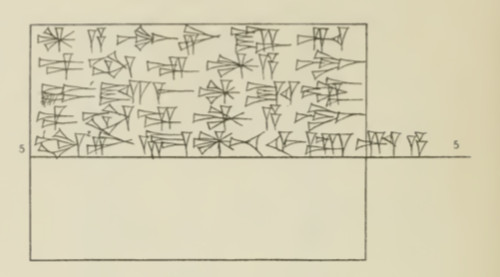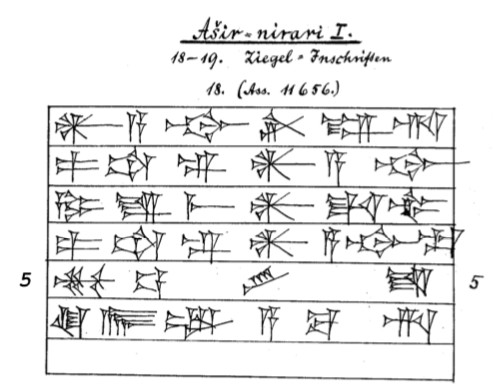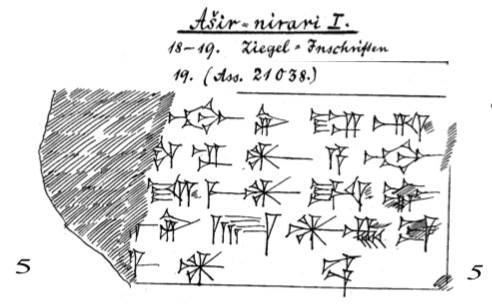Aššur-nārārī I
The Assyrian King List [/riao/KingLists/AssyrianKingList/AssyrianKingList/index.html#BelubaniDynasty] (AKL) records that Aššur-nārārī, son of Išme-Dagān II, ruled Assyria for twenty-six years (ca. 1500 BCE). This Old Assyrian ruler is included in the Synchronistic King List [/riao/KingLists/SynchronisticKingList/index.html] as a contemporary of the Babylonian king Kaštiliašu III; this synchronism, however, is probably an error. According to the so-called Synchronistic History, his son Puzur-Aššur III was engaged in political relations with the Babylonian king Burna-buriaš I, the father of Kaštiliašu III (Grayson 2000:158-159). In his own inscriptions, Aššur-nārārī I commemorated some of his building projects at Aššur, including the double-temple of the moon-god Sîn and the sun-god Šamaš and one of the city's walls.
Bibliography
Browse the RIA 1 Corpus [/riao/ria1/pager/]
01

VA 06928 (Ass 02776) and Ist EȘEM 09274 (Ass 02348). Messerschmidt, KAH 1 no. 62
Numerous bricks from Aššur are inscribed with a five-line text of Aššur-nārārī I in which he referred to himself as the "builder of the temple of the god Bēl-ibrīya." Some of these bricks are now housed in the Eski Șark Eserleri Müzesi of the Arkeoloji Müzeleri (Istanbul) and Vorderasiatisches Museum (Berlin).
Access the composite text [/riao/ria1/Q005686/] of Aššur-nārārī I 01.
Bibliography
02

Schroeder, KAH 2 no. 18 (exs. 1-5, copy)
Nine bricks discovered at Aššur state that Aššur-nārārī I restored the Abaru Forecourt, the large courtyard of the Aššur temple. Some of the bricks are now in Berlin (Vorderasiatisches Museum), while others are in Istanbul (Eski Șark Eserleri Müzesi of the Arkeoloji Müzeleri).
Access the composite text [/riao/ria1/Q005687/] of Aššur-nārārī I 02.
Bibliography
03

Ass 021038. Schroeder, KAH 2 no. 19
A five-line text written on a brick refers to Aššur-nārārī I as "the builder of the temple of the gods Sîn [and] Šamaš." The present location of this object is unknown.
Access the composite text [/riao/ria1/Q005688/] of Aššur-nārārī I 03.
Bibliography
04
A fragment of a clay cone now in Berlin (Vorderasiatisches Museum) bears part of an inscription stating that Aššur-nārārī I renovated the Step Gate at Aššur.
Access the composite text [/riao/ria1/Q005689/] of Aššur-nārārī I 04.
Bibliography
05
A damaged clay cone inscribed with a text recording work on a (fortification) wall of the city Aššur. It is now housed in the Eski Șark Eserleri Müzesi of the Arkeoloji Müzeleri (Istanbul).
Access the composite text [/riao/ria1/Q005690/] of Aššur-nārārī I 05.
Bibliography
06
A fragment of a clay cone now in the Brotherton Library of the University of Leeds preserves the first seven lines of an inscription of Aššur-nārārī I from Aššur. The text records that this ruler constructed (or renovated) a wall.
Access the composite text [/riao/ria1/Q005691/] of Aššur-nārārī I 06.
Bibliography
07
A stone fragment from Aššur preserves the name, title, and genealogy of Aššur-nārārī I. The section recording the building account is not preserved. The present location of this object is not known.
Access the composite text [/riao/ria1/Q005692/] of Aššur-nārārī I 07.
Bibliography
08
A clay cone fragment from Aššur preserves parts of the first four-lines of an inscription of Aššur-nārārī I; only his name, title, and genealogy survive. The object is currently in Istanbul (Eski Șark Eserleri Müzesi of the Arkeoloji Müzeleri).
Access the composite text [/riao/ria1/Q005693/] of Aššur-nārārī I 08.
Bibliography
09
A fragment of a clay cone found at Aššur and now in the Vorderasiatisches Museum (Berlin) bears the opening three lines of an inscription of Aššur-nārārī I.
Access the composite text [/riao/ria1/Q005694/] of Aššur-nārārī I 09.
Bibliography
10
A small piece of a clay cone preserves the name of the ruler Aššur-nārārī I. The object originated in Aššur and is now in Istanbul (Eski Șark Eserleri Müzesi of the Arkeoloji Müzeleri).
Access the composite text [/riao/ria1/Q005695/] of Aššur-nārārī I 10.
Bibliography
Jamie Novotny & Yehonatan Hershkovitz
Jamie Novotny & Yehonatan Hershkovitz, 'Aššur-nārārī I', RIA 1: Inscriptions from the Origins of Assyria to Arik-dīn-ili, The RIA Project, 2024 [http://oracc.org/OldAssyrianPeriod/Belu-baniDynasty/Ashur-narariI/]